Iphone Tips and Tricks | Iphone tips | Iphone Tips and Tricks 2022/2021
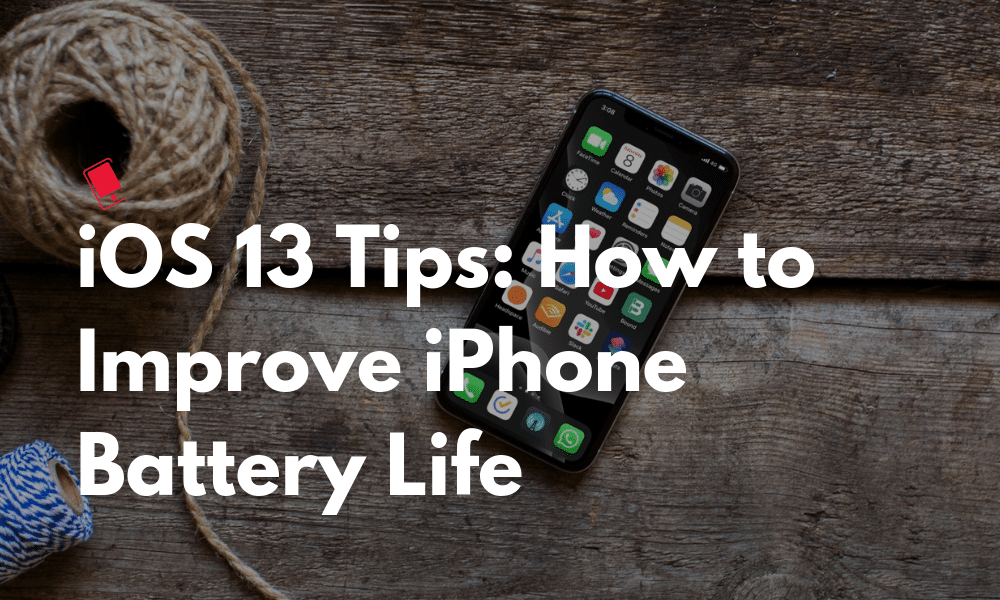
If you have installed iOS 13 – iOS 13.7 and noticed that your iPhone’s battery is draining fast then you have come to the right place. In this guide, we will show you how to diagnose and fix bad iPhone battery life issues on iOS 13.
Does iOS 13 Improve or Drain iPhone Battery Life?
iOS 13 can help improve battery life as it includes features such as Dark Mode. Tests have shown that Dark mode brings noticeable improvements in iPhone battery life.
How to Check iPhone Battery Life
Before we proceed further giving you tips on how to fix iOS 13 – iOS 13.7 battery life problems, we think it is important to know how much battery life your iPhone is expected to deliver, so you can gauge for yourself if you should be concerned about battery life. For example, below is the iPhone XS and iPhone XS Max battery life from the tech specs page on Apple’s website.
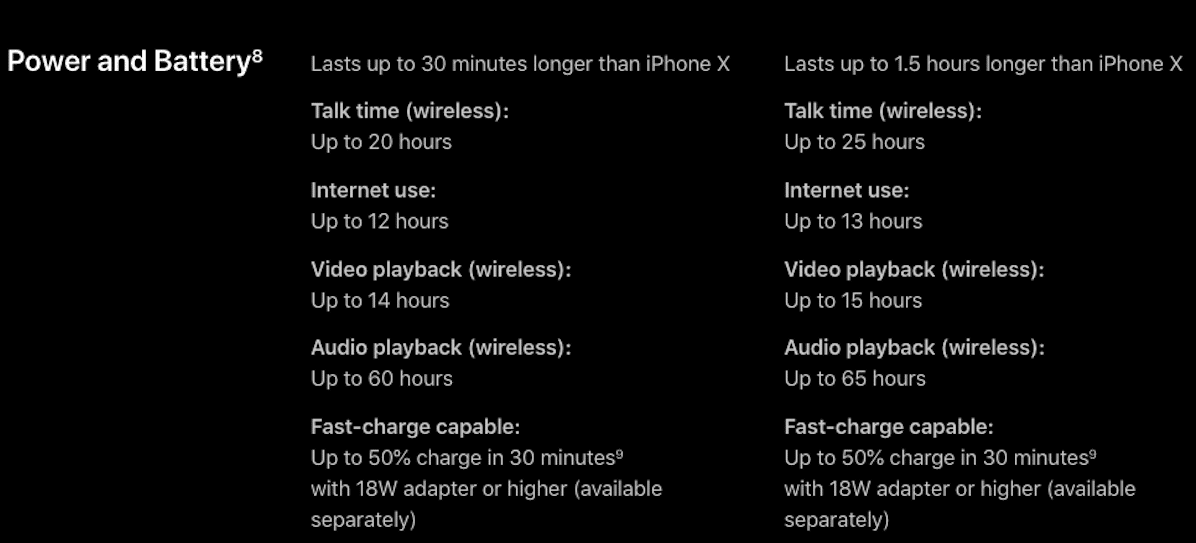
It is important to understand that your battery life will vary as per your usage, so if you listen to your music locally from the Music app and not stream off LTE/3G/Wi-Fi, your battery life would last much longer.
You can check the battery life or usage and standby time since the last full charge via the Settings app under Activity and the Battery Usage By App section (Settings > Battery).
Usage is the amount of time iPhone has been awake and in use since the last full charge. The phone is awake when you’re on a call, using email, listening to music, browsing the web, or sending and receiving text messages, or even during certain background tasks such as auto-checking email.
Battery Percentage
On iPhone 8, iPhone 8 Plus or earlier iPhone models, iOS displays the battery level in the top right corner of the status bar by default. You can keep track of the charge remaining in your iPhone more easily by enabling the battery percentage indicator, which displays the battery left in percentage. To display the battery percentage indicator, navigate to Settings > General > Usage and scroll down and tap on the Battery Percentage toggle to enable it.
In the case of iPhone X, iPhone XS, iPhone XS Max, and iPhone XR, there is no setting to enable battery percentage in the status bar unless you have jailbroken your iPhone and installed the BatteryPercentX tweak. You need to swipe down from the top-right part of the screen – the right ear next to the notch. This will bring the Control Center. But the way Control Center animates, you see the top items first and fairly quickly. At the top, you’ll find status bar icons that couldn’t fit next to the notch. The first of which is the battery percentage.
Now that you know how much battery life you should expect and you can track it with the battery percentage indicator, let us see how you can extend your iPhone’s battery life.
Tips on How to Improve iPhone Battery Life from Apple
In iOS 12, Apple introduced a feature that provided recommendations on settings changes to improve battery life. You can access them by navigating to Settings > Battery > Battery Health.
You can tap on each suggestion to jump directly to the setting that you need to change. If you don’t see any suggestions, then check our tips to help you manage and fix battery life problems if your iPhone battery is draining fast after installing iOS 13 – iOS 13.7 update.
Tips to Improve iPhone Battery Life on iOS 13
1. Install Latest iOS 13 Software Update
Install the latest software update for iOS 13, to ensure that any bugs that may be affecting battery life have been fixed. To check if you need to install an iOS 13 software update, navigate to Settings > General > Software Update.
Some users are reporting that their iPhone battery is draining faster after upgrading to iOS 13.5.1.
2. Identify iPhone apps Draining Battery Life
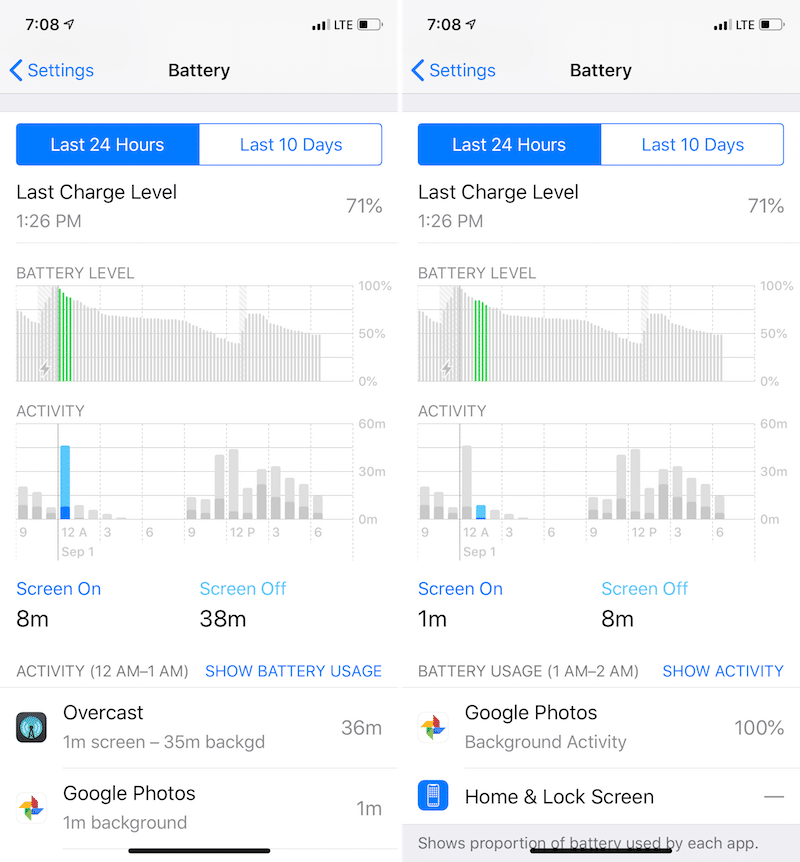
iOS makes it much easier to identify apps that are draining iPhone battery life. You can check our step-by-step guide on how to identify apps draining iPhone battery life. For example, in iOS 13.5.1, the likely cause of battery drain on iPhones running iOS 13.5.1 could be the background activity by the Music app.
What Next
If you’ve identified an app that is draining battery life on your device, here are some of the things you can do to improve iOS 13 battery life, especially if it is a third-party app:
- If you can live without the app then the best thing to do is delete the app.
- While iOS takes care of suspending apps in the background, it’s likely that some apps wake up in the background to fetch content off the network. You may want to force close apps like VoIP, navigation, and streaming audio apps if you’re not using them as they’re known to drain battery life. It is important to note here that you should only close apps that you don’t want to use. It is not a good practice to force close all apps, as that could have an adverse impact on battery life. Force close an app by swiping up from the Home indicator and stop when you see the animation. Now lift your finger and you’ll see all the apps in the horizontal list. Tap and hold on one of the cards and you’ll see red minus buttons in the top-left corner of each app card. Now, you can swipe up on any app to quit them.
- If you want to use the app, then you should seriously consider disabling Location Services (Settings > Privacy > Location Services) and Background app refresh (Settings > General > Background App Refresh) features for the app as they can end up consuming battery life. We will cover it in more detail next.
3. Disable Location Services
When we install apps, they prompt us to give them access to various things such as location, etc., and we tend to blindly say yes. However, apps using location services can have a major impact on battery life. So you may want to review which apps should have access to your device’s location.
The best way to approach this is to first disable location services for all the apps. You can disable location services via the Settings app and navigate to Privacy > Location Services. After you’ve disabled location services for all apps, you identify which apps such as navigation apps should use location services and enabled them individually.
Use Location Only While Using the app
In iOS, you can allow apps to use Location Services only while using the app, so the apps don’t use battery consuming GPS feature all the time. This can be useful for apps like the App Store, which don’t need to be using location services all the time.
You can see which applications have recently used location services by going to Settings > Privacy > Location Services. Apps that recently used your location have a compass-like indicator next to them. Tap on the app, you should see the While Using the App, tap on it if you want the app to use location services only while using the app. This will ensure that the app will access your location only when it or one of its features are visible on the screen. As you can see below, iOS also tells you the App Store app is using location services to “find relevant apps nearby”.
With iOS 13, you can give an app access to the location just once. So the app will prompt you to provide access when you use it the next time. You can also change the settings for apps to use the location once by selecting the new “Ask Next Time” option.

If you’ve accidentally disabled location services for an app that needs to use it, don’t worry, it will prompt you to give access to Location Services when you launch it.
4. Disable Background App Refresh
iOS includes smarter multitasking that lets apps fetch content in the background. Although Apple has a lot of optimizations in place to ensure that battery consumption is minimal, it’s possible that a poorly developed app could be using this feature, which could end up draining battery life. To disable Background App Refresh go to Settings > General > Background App Refresh > and turn it off for apps like Facebook or other apps that don’t absolutely need to be updated all the time. Background App Refresh is a great feature, but you don’t need it for every app.
I would strongly recommend turning it off for the Facebook app as it is known to drain battery life.
You have the option to enable Background App Refresh only when you’re on a Wi-Fi network. You could see if selecting just Wi-Fi reduces the battery drain on your iPhone or you may want to turn off completely. It will also help in saving mobile data on your iPhone.
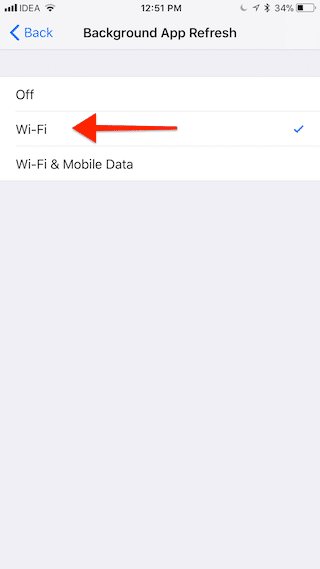
5. Use Dark Mode
After years of wishing for it, Apple has finally added support for Dark mode in iOS 13. Once enabled, it is system-wide. It stretches from the dynamic wallpaper to the widgets screen, to the Settings screen and apps that have added support for Dark mode. It should help in improving battery life on iPhones with an OLED display like the iPhone XS, iPhone XS Max, and iPhone X.
When you install the iOS 13 software update on your iPhone and iPad, the onboarding process will ask you if you want to switch to the Dark mode. Even if you don’t select it then, you can always go to the Control Center, press on the Brightness slider, and then tap on the Appearance button to switch between the Light and the Dark mode.
You can set the dark mode on a schedule as well. Go to Settings -> Display and Brightness and turn on the Automatic option. Then tap on Settings to switch to a custom schedule. By default, the dark mode will turn on automatically after sunset. You can check our article to learn how to enable Dark mode on your iPhone or iPad.
6. Use Low Power Mode
If your device is running low on battery, and you still have some time to get to a power source, then you could enable the all-new Low Power mode by going to Settings > Battery and tapping on the toggle. Low Power Mode temporarily reduces power consumption by turning off or reducing mail fetch, background app refresh, automatic downloads, and some visual effects. Apple states that Low Power Mode mode can improve battery life by an additional 3 hours.
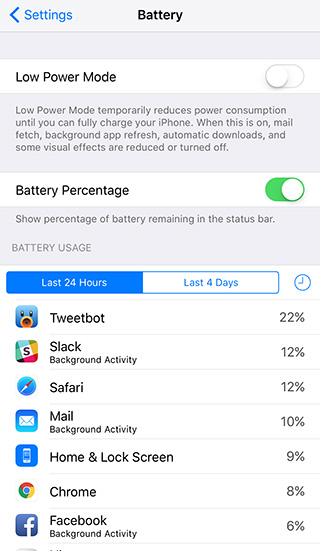
You will also get a prompt to enable Low Power Mode when you hit 20% battery remaining, and will automatically disable it when battery remaining crosses 80%.
7. Place iPhone Facedown
iOS includes a facedown detection feature, which makes use of the ambient light sensor to ensure the display doesn’t light up when you receive a Notification when you place the iPhone facedown. The feature along with other refinements helps in increasing battery life by an additional hour as it turns off the display when not in use. So when you place your iPhone on the table, you should place it facedown to conserve battery life. Please note the Facedown Detection feature is available only on iPhone 5s or later devices.
8. Turn Off Raise to Wake
The Raise to Wake feature automatically turns on the screen of your iPhone every time you pick it up and it’s facing towards you. This is very useful if you want to wake your iPhone just to check the received notification or the time. Rather than using the Home button, you can simply pick up your device to turn on the display.
It is useful, but it also can drain battery life if you have the iPhone in your hand while walking, jogging, dancing, or otherwise moving around while the feature is activating itself frequently. Turn it off to save some battery life by navigating to Settings > Display & Brightness > Raise to Wake > toggle OFF.
Once Raise to Wake is disabled, the iPhone will no longer turn the screen on itself just by an upward motion alone.
9. General Tips
Please note that the tips under section are to highlight areas where you could disable things that are not applicable to you so you can extend battery life. We are not recommending or advising you to disable features just for battery life, as then there would be no point in using smartphones like the iPhone.
i. Widgets
The Widgets in the Lock Screen and Notification Center (when you swipe left) includes widgets for Stock and Weather and any other third-party Notification Center widget you may have added. You should review the list and remove the widgets that you don’t want to ensure they don’t consume battery life unnecessarily as some of them could be using Location services.
Check out our post to find out how to disable the unwanted widgets.
ii. Turn off Dynamic Wallpapers
Dynamic wallpapers bring subtle animations to the home and the lock screen. Unfortunately, the animations take up CPU cycles and consume more battery. So if you have set a dynamic wallpaper, and you’re having battery issues, go to Settings > Wallpaper > Choose Wallpaper where you can go to either Stills or your set an image from your photo library as your wallpaper. iPhone 6s or later also allows you to set Live Photos as wallpapers, but it should have an impact on battery life as they come to life only when you use 3D Touch to firmly press on the wallpaper.
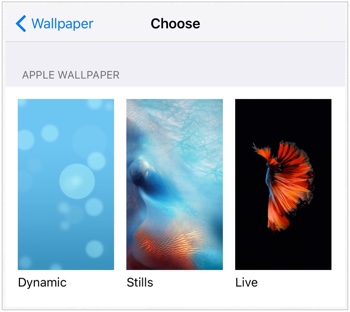
iii. Disable Motion effects, parallax
iOS comes with a number of animations and physics-based effects to the interface to help users understand the layered elements in the UI. Some of these effects even access gyroscopic data, which contributes further to the battery drain. You can disable these motion effects by going to Settings > General > Accessibility > Reduce Motion and turn on the switch. However, please note that enabling Reduce Motion will disable the effects in the Messages app.
iv. Other tips
- If you hardly use Bluetooth then turn it off (Settings -> General -> Bluetooth)
- Set Auto-Lock interval so that your iPhone will turn off more quickly after a period of inactivity. To set the Auto-Lock interval, launch the Settings app, tap on General and then Auto-Lock, and set the auto-lock interval to either 30 seconds, 1, 2, 3, 4, or 5 minutes.
- You’re probably aware that using Wi-Fi drains iPhone’s battery, but perhaps you didn’t know that one of the most intensive processes that iPhone’s Wi-Fi chip has to do is search for the available network. So if this happens at regular intervals, it’s going to have a noticeable impact on your battery. To disable this feature, launch the Settings app, tap on Wi-Fi, and tap on the On/Off toggle for Ask to Join Networks to disable it. Please note that by disabling this feature, your iPhone will join known Wi-Fi networks automatically, but you will have to manually select a network if no known networks are available. Note: It is disabled by default.
- Dimming the screen helps to increase battery life. You can either lower the default screen brightness based on your preference or turn on Auto-Brightness to allow the screen to adjust its brightness based on current lighting conditions. Launch the Settings app, scroll down and tap on Brightness & Wallpaper and set Auto-Brightness to On. Note: Apple enables it by default.
- Turn off Location Services for the following System System services: Diagnostics & Usage, Setting Time Zone, Location-Based iAds (Settings -> Privacy -> Location Services -> System Services).
10. Troubleshooting Tips
i. Hard Reset Your iPhone
Like all tech problems, there is no harm in force restarting or hard resetting your iPhone or iPad to see it helps.
- On an iPhone XS, iPhone XS Max, iPhone XR, iPhone X, iPhone 8, and iPhone 8 Plus, press and quickly release the Volume Up button. Press and quickly release the Volume Down button. Then press and hold the Side button until you see the Apple logo.
- On an iPhone 7 or iPhone 7 Plus, press and hold both the Side and Volume Down buttons for at least 10 seconds, until you see the Apple logo.
- On an iPhone 6s and earlier, iPad, or iPod touch; press and hold both the Home and the Top (or Side) buttons for at least 10 seconds, until you see the Apple logo.
- On an iPad Pro 11-inch or iPad Pro 12.9-inch, press and quickly release the Volume Up button. Press and quickly release the Volume Down button. Then press and hold the Power button until the device restarts.
ii. Resetting Network Settings
Reset network settings by tapping Settings -> General -> Reset -> Reset Network Settings. This will reset all network settings, including passwords, VPN, and APN settings.
iii. Battery Maintenance
Apple advises users to go through at least one charge cycle per month (charging the battery to 100% and then completely running it down). So if you haven’t done it already, it may be a good time to do it. Power cycling your device helps in recalibrating the battery indicator more accurately. In iOS 13, Apple has also introduced a new feature to optimize iPhone battery charging to increase the life span of your iPhone’s battery.
Check our post which provides tips to prolong the iPhone battery’s lifespan.
11. Restore iPhone as New
Try to restore your iPhone (Settings -> General -> Reset -> Erase All Content And Settings) and set it up as a new iPhone (not from the backup).
Before you erase all the contents and settings, take a backup of your iPhone using iTunes or iCloud, or selectively take a backup of your photos and videos using Dropbox or Google+.
We’ve seen quite a few comments from readers who have found that the battery life is better after setting up the device as a new iPhone







0 Comments